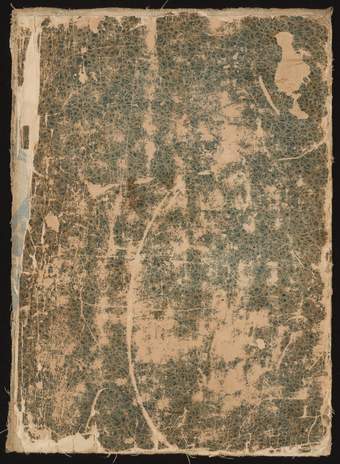Alison Smithson’s scrapbook
1845–2002

Alison Smithson studied architecture at King’s College, Durham from 1944-9, where she met her future husband and partner Peter. Alison and Peter briefly joined the architecture department of London County Council in 1949 before forming their own partnership in 1950. From 1952 the Smithsons were involved in the Independent Group, and with Nigel Henderson, Eduardo Paolozzi and other, staged the significant Parallel of Life and Art exhibition at the ICA in 1953. The Smithsons first major architectural commission, for Hunstanton School in Norfolk, was an outrunner for a style which came to be known as ‘New Brutalism’. The Smithsons had to wait a decade to complete another major building, the Economist Cluster, and 10 years later they completed their final significant building, the Robin Hood Gardens estate in 1972. Between these major projects the Smithsons devoted their energy to writing extensively on architectural theory and this scrapbook is a visual catalogue of Alison’s theoretical thinking. The base of the work is Charles Knight’s 'Old England: A Pictorial Museum of Regal, Ecclesiastical, Municipal, Baronial, and Popular Antiquities' (1845) to which, from the 1940s until her death in 1993, Alison inserted and pasted images taken from magazines, packaging, brochures, books and postcards – a use of found objects in keeping with one of the central themes of the Independent Group’s work. Knight’s original imagery peeks through among Smithson’s additions; a juxtaposition Smithson posed as an ‘Old England’ against a contemporary world of globalisation and commodity culture. The scrapbook exemplifies a woman’s thought-collage drawn from the British past and postcolonial present of Alison’s life, with significant feminist undertones. It provides a rare opportunity to explore Smithson’s visual repertoire and her legacy in British art, design and architecture.
- Collection Owner
- Alison Smithson 1928–1993
- Collection
- Tate Archive
- Acquisition
- Presented by the Smithson Family Collection 2024
- Reference
- TGA 20245
1 object in this collection
- Title
- Alison Smithson’s scrapbook
- Date
- 1845–2002
- Description
- Alison Smithson studied architecture at King’s College, Durham from 1944-9, where she met her future husband and partner Peter. Alison and Peter briefly joined the architecture department of London County Council in 1949 before forming their own partnership in 1950. From 1952 the Smithsons were involved in the Independent Group, and with Nigel Henderson, Eduardo Paolozzi and other, staged the significant Parallel of Life and Art exhibition at the ICA in 1953. The Smithsons first major architectural commission, for Hunstanton School in Norfolk, was an outrunner for a style which came to be known as ‘New Brutalism’. The Smithsons had to wait a decade to complete another major building, the Economist Cluster, and 10 years later they completed their final significant building, the Robin Hood Gardens estate in 1972. Between these major projects the Smithsons devoted their energy to writing extensively on architectural theory and this scrapbook is a visual catalogue of Alison’s theoretical thinking. The base of the work is Charles Knight’s 'Old England: A Pictorial Museum of Regal, Ecclesiastical, Municipal, Baronial, and Popular Antiquities' (1845) to which, from the 1940s until her death in 1993, Alison inserted and pasted images taken from magazines, packaging, brochures, books and postcards – a use of found objects in keeping with one of the central themes of the Independent Group’s work. Knight’s original imagery peeks through among Smithson’s additions; a juxtaposition Smithson posed as an ‘Old England’ against a contemporary world of globalisation and commodity culture. The scrapbook exemplifies a woman’s thought-collage drawn from the British past and postcolonial present of Alison’s life, with significant feminist undertones. It provides a rare opportunity to explore Smithson’s visual repertoire and her legacy in British art, design and architecture.
- Reference
- TGA 20245

